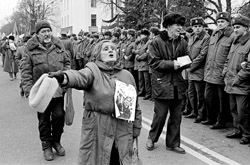Gongadze case hits the streets

Under the slogan, Ukraine without Kuchma, protesters held a rally and marched to the Verkhovna Rada last Tuesday. On December 15, 1990 student hunger strike veterans, lawmakers, members of fifteen political parties and organizations erected a tent town on the capital’s Independence Square (Maidan Nezalezhnosty), modeled on that of the so-called granite revolution of 1990, demanding that the president, SBU head, internal affairs minister, and head of the tax service resign. They also demanded an independent investigation of the Gongadze case. For three days the protesters urged Kyivans approaching their ersatz lodgings to join their anti-presidential march to Verkhovna Rada and the Presidential Administration.
Tentative estimates point to some 5,000 persons gathered on Independence Square the morning of December 19. Judging by a kind of roll call held by the organizing committee, the action involved mostly Communists, Socialists, both factions of Rukh, and Right radical organizations, by and large people in their middle years that are now perhaps the most politically active and impoverished segment of the population. Among those addressing the rally were Deputies Anatoly Matviyenko, Hryhory Omelchenko, Oleksandr Moroz, and Petro Symonenko. Interestingly, the latter first openly joined Moroz’s campaign that day. This was additional proof of the anti-ideological, frankly personal character of the rally. Socialist leader Oleksandr Moroz addressed the audience, among them people from other regions of Ukraine, saying, “We are struggling not against the regime, but for investigating the Gongadze case and implementing the Verkhovna Rada resolutions concerning the dismissal of the heads of the law enforcement structurs.” His Communist counterpart spoke for a decisive struggle against the existing system which he said was destroying the people. “Kuchma is a product of this system,” he declared (so was Comrade Symonenko, just a bit lower down the hierarchy — Ed.) and urged returning power “to the people,” unity, and deciding through Verkhovna Rada who should wield this power.
At noon, the protesters set off on their march to Parliament. The organizers called on the marchers to keep order and discipline. The national flag (unfurled over the tent town since Friday) was carried in front of the column, followed by the supporting people’s deputies and the rest of the protesters and sympathizers.
Vadym Hladchuk, leader of Youth the Hope of Ukraine, told The Daythat his organization was also supporting the act of protest, although he believed that “before ousting the President, independent foreign experts should examine Oleksandr Moroz’s cassette.”
Around 1:00 p.m., the protesters met with the presidential supporters by Verkhovna Rada (actually some of the posters carried by the supporters pointed to their opposition to parliament). The two columns were cordoned off by the militia. The latter was tolerant of the media people present and let them pass through the cordon. Most of the president’s exponents were young people. Smiling, they told journalists that each had received ten hryvnias for joining the action. All told, some 500 persons showed up to support the president.
The protesters, after waiting for a while and holding counsel, decided to approach parliament on the side of General Vatutin’s statue. Considering that the protesting column was led by lawmakers, the militia pushed the president’s supporters closer to the sidewalk to let the protesters march by, thus averting a head-on collision.
Twenty minutes later, some thirty protesters forced their way through the militia cordon and approached the Verkhovna Rada building. They demanded to see Speaker Ivan Pliushch so that they could hand him their message.
After a while the speaker appeared and urged those present to remain calm. In a tight circle of journalists and bodyguards, he could communicate with the rally only through a bullhorn.
“If we hold dear our Ukraine, let us live and work in peace,” he declared, stressing that under the circumstances the most important thing was to preserve “the fragile harmony we have been able to maintain of late. As for the Gongadze case and other evidence being discussed in Ukraine and beyond its borders, these problems can be solved only in accordance with the law.”
Speaker Pliushch informed the protesters that Verkhovna Rada had passed a number of recommendatory resolutions and forwarded them to the president. He added that, in his opinion, the chief of state would take them into consideration after receiving the relevant documents.
Vasyl Chemerys, one of the organizers of the Ukraine without Kuchma action, told journalists that the protesters were not satisfied by what they had heard from Ivan Pliushch and that they would continue to campaign for the implementation of their demands. Meanwhile a number of political forces voiced their views on what was happening in Kyiv’s streets.
Prior to the protesters’ march, Oleksandr Moroz admitted that his statement and public exposure of the audio and video cassettes were playing into the government’s hand. “In a sense, the threat of the cabinet’s removal from the political arena was lifted after I made my statement,” he is quoted as saying by Interfax Ukraine. Simultaneously, the Socialist leader noted that this was not his objective. Be it as it may, Ukraine’s image is too dear a price to pay for the government status of individual politicians.






